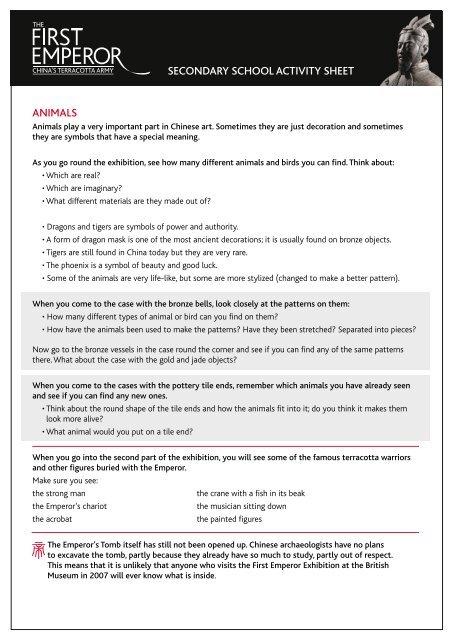RESOURCES FOR TEACHERS - British Museum
RESOURCES FOR TEACHERS - British Museum
RESOURCES FOR TEACHERS - British Museum
Create successful ePaper yourself
Turn your PDF publications into a flip-book with our unique Google optimized e-Paper software.
SECONDARY SCHOOL ACTIVITY SHEET<br />
ANIMALS<br />
Animals play a very important part in Chinese art. Sometimes they are just decoration and sometimes<br />
they are symbols that have a special meaning.<br />
As you go round the exhibition, see how many different animals and birds you can find. Think about:<br />
• Which are real?<br />
• Which are imaginary?<br />
• What different materials are they made out of?<br />
• Dragons and tigers are symbols of power and authority.<br />
• A form of dragon mask is one of the most ancient decorations; it is usually found on bronze objects.<br />
• Tigers are still found in China today but they are very rare.<br />
• The phoenix is a symbol of beauty and good luck.<br />
• Some of the animals are very life-like, but some are more stylized (changed to make a better pattern).<br />
When you come to the case with the bronze bells, look closely at the patterns on them:<br />
• How many different types of animal or bird can you find on them?<br />
• How have the animals been used to make the patterns? Have they been stretched? Separated into pieces?<br />
Now go to the bronze vessels in the case round the corner and see if you can find any of the same patterns<br />
there. What about the case with the gold and jade objects?<br />
When you come to the cases with the pottery tile ends, remember which animals you have already seen<br />
and see if you can find any new ones.<br />
• Think about the round shape of the tile ends and how the animals fit into it; do you think it makes them<br />
look more alive?<br />
• What animal would you put on a tile end?<br />
When you go into the second part of the exhibition, you will see some of the famous terracotta warriors<br />
and other figures buried with the Emperor.<br />
Make sure you see:<br />
the strong man the crane with a fish in its beak<br />
the Emperor’s chariot the musician sitting down<br />
the acrobat the painted figures<br />
The Emperor’s Tomb itself has still not been opened up. Chinese archaeologists have no plans<br />
to excavate the tomb, partly because they already have so much to study, partly out of respect.<br />
This means that it is unlikely that anyone who visits the First Emperor Exhibition at the <strong>British</strong><br />
<strong>Museum</strong> in 2007 will ever know what is inside.
















